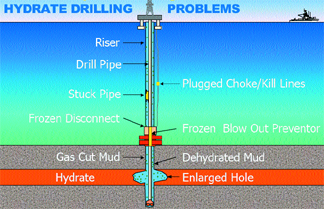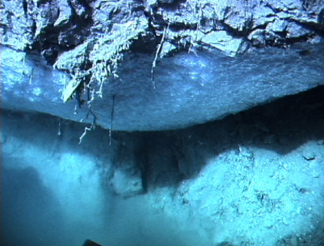Mining
for tomorrow
 The
future is a long way off when it comes to prospects for mining and producing
gas hydrates from marine sediments. Although some land-based recovery
operations have had success, marine sites will remain difficult, if not
technologically surreal.
The
future is a long way off when it comes to prospects for mining and producing
gas hydrates from marine sediments. Although some land-based recovery
operations have had success, marine sites will remain difficult, if not
technologically surreal.
Marine gas hydrates could clog choke lines that deliver lubricant to drillheads,
or freeze pipes and blowout preventers, and cause a variety of other problems,
should they be mined with traditional drill-well technology. Any solutions,
at this point, remain futuristic. Image courtesy of Maurer Technology.
“Mining is definitely way off into the future,” says George
Moridis of Lawrence Berkeley National Lab in Berkeley, Calif. Moridis
notes success in permafrost regions such as the Mallik site in the Arctic,
where gas hydrates have been successfully heated or depressurized in order
to capture the natural gas trapped in the icy structures (see story,
"Fire in Ice"). In water, “the basic approach up to now
[would be] to use conventional technology,” he says. But “the
deeper you are, the more expensive it is and more difficult it is.”
Like conventional drilling for oil and gas in ocean settings, future drilling
for marine gas hydrates might involve a platform or riser, or even a drill
ship, that sinks a drill pipe into the seafloor. The drill head would
be lubricated by a heavy fluid, as in normal drilling, but to make sure
that the heat of drilling does not dissociate gas hydrates — which
come apart with increases in temperature or decreases in pressure —
cool water could be pumped in from the ocean water column, from an insulated
pipe.
In projects that core hydrates, such as legs of the Ocean Drilling Program
in the Pacific Northwest, and in Japanese drilling projects already under
way, researchers do not use risers partly because blowouts are a distinct
possibility. Working without a riser leaves room for escaping gas, according
to Tom Williams, vice president of the geophysical engineering group Maurer
Technology. In the right conditions, gas from hydrates can be compressed
more than 600 times what it would be normally, “so you can imagine
how [the] gas would expand as it travels up a riser,” he says. “This
could be a major blowout — not unlike a rocket headed straight up
the riser toward the drill ship” (see sidebar [in print only], page
21).
Even on land or in traditional marine drilling without the presence of
gas hydrates, such blowouts are still a concern. But if a submarine deposit
were destabilized, and the gas hydrate layer was acting as a cap for a
free-gas layer below, the consequences could be a huge gas bubble traveling
up through the water column, Moridis says. But he notes that marine hydrates
might also be somewhat easier to produce because of the incremental inhibiting
benefits of salt.
A more futuristic scenario for gas hydrate mining envisions production
almost at the source, using a drilling rig firmly anchored on the seafloor,
perhaps operated remotely by a ship above. Future gas hydrate miners could
“theoretically bring it up in the same form as it is so it doesn’t
turn to gas and expand,” Williams says. But the technology to transport
gas hydrates from seafloor to sea surface remains unimagined at the moment.
Some scientists remain skeptical that deepwater hydrates will be mineable
at a large scale. “Most gas hydrates are finely dispersed in sediments
and will never be recoverable economically,” says Alexei Milkov of
BP, who cites significantly lower amounts of marine gas hydrate than others
(see story). However, profitable recovery of localized
highly-concentrated gas hydrate accumulations is possible, he adds.
Practically speaking, Williams says, “we really need to get a better
understanding of the resource before we decide how to mine it.”
NL
Back to top

 Policy-makers and geoscientists
alike have hopes for gas hydrates as a new source of energy, but exactly how much
of the icy substance exists remains contentious (see story).
Part of the problem is that methods to image them in deepwater deposits around
the world have had varied and sometimes limited success. To better find large
enough deposits to extract, in addition to resolving issues of safety and climate
effects (see story), scientists are working to improve seismic
profiling techniques and other tools for better mapping of gas hydrates.
Policy-makers and geoscientists
alike have hopes for gas hydrates as a new source of energy, but exactly how much
of the icy substance exists remains contentious (see story).
Part of the problem is that methods to image them in deepwater deposits around
the world have had varied and sometimes limited success. To better find large
enough deposits to extract, in addition to resolving issues of safety and climate
effects (see story), scientists are working to improve seismic
profiling techniques and other tools for better mapping of gas hydrates. 